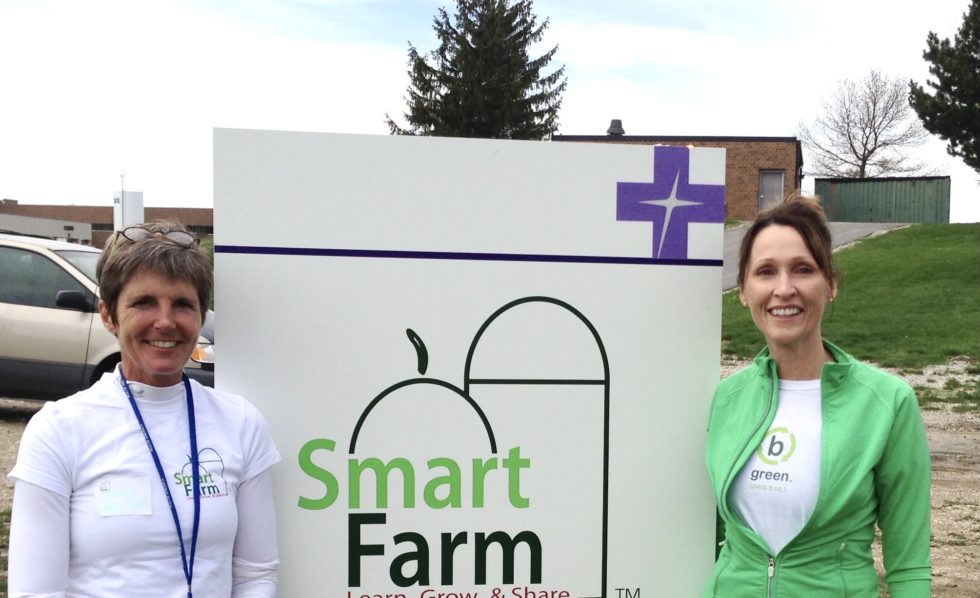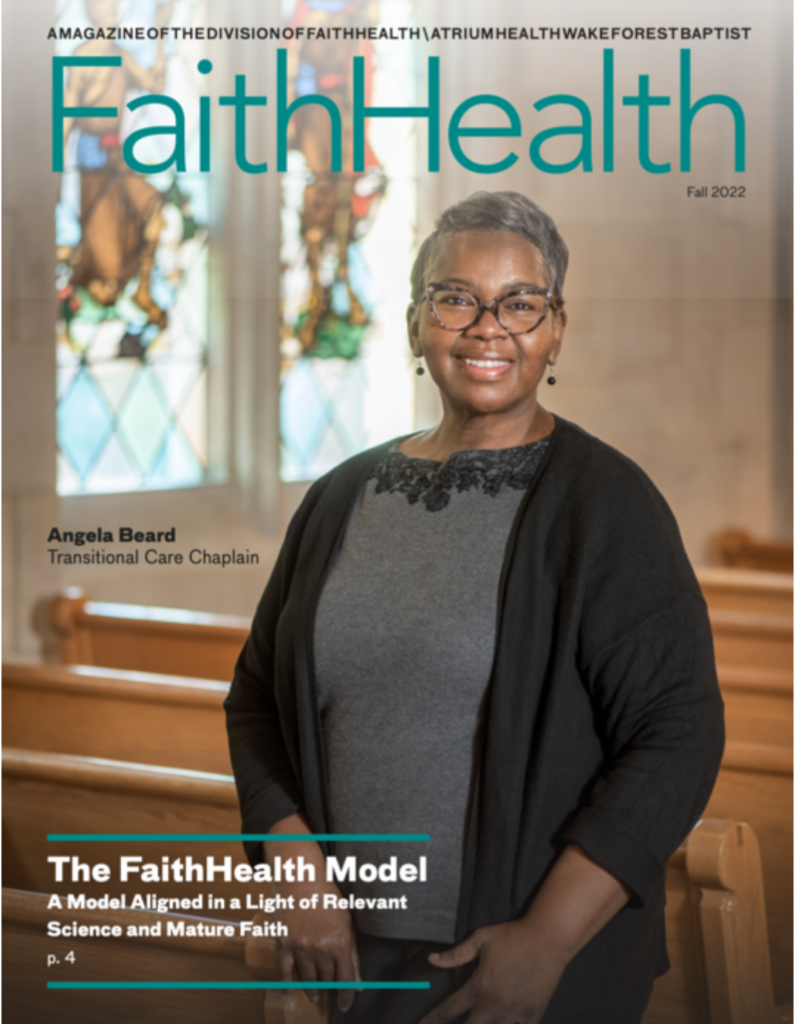
Advocate Aurora Health recently committed to power its operations with 100% renewable electricity by 2030. A bold goal, to be sure, but the health system’s environmental focus has humbler beginnings.
By Tom Peterson
Mary Larsen (above right), director of environmental affairs and sustainability for Advocate Aurora, tells of one of those moments. She had been working in operations at Chicago-based Advocate Health Care when, in 2004, the hospital’s president decided to pursue LEED Gold certification for a new bed tower. LEED (Leadership in Energy and Environmental Design) is the widely used system for rating green buildings. Larsen was asked to participate in the construction project planning team for this initiative, and they built the first LEED Gold certified hospital building in the American Midwest.
 Being a part of the early days of the green building movement, learning the rationale behind it and all the positive benefits was eye-opening for Larsen, she reports. And in an aha moment, she realized the irony of unintended consequences of some operations while promoting health for the community. “We use energy 24/7, we create a lot of waste with many complex waste streams, and we could inadvertently be doing harm.” Connecting that with the physician’s motto, first do no harm, says Larsen, “was my catalytic moment.”
Being a part of the early days of the green building movement, learning the rationale behind it and all the positive benefits was eye-opening for Larsen, she reports. And in an aha moment, she realized the irony of unintended consequences of some operations while promoting health for the community. “We use energy 24/7, we create a lot of waste with many complex waste streams, and we could inadvertently be doing harm.” Connecting that with the physician’s motto, first do no harm, says Larsen, “was my catalytic moment.”
In 2011, Larsen was asked to lead and operationalize environmental sustainability for the entire Advocate Health Care system. Starting “really from a blank slate,” she realized that this meant more than the nitty gritty of greening all aspects of the operations, but that it was also about culture change. “I knew it had to be top-down and bottom-up to shift the mindset and win hearts and minds about the importance of conservation and stewardship of our resources if we were going to see the necessary behavior changes. I needed to make the case to all kinds of stakeholders about why this is important for the organization and its mission and then to develop the how.”
The Power of $20 Billion
Advocate was one of the founding health systems of the Healthier Hospitals Initiative, a coalition of leading health systems and the advocacy organizations Practice Greenhealth and Health Care Without Harm. The initiative was created to improve sustainability performance with a focus on safer chemicals, healthier food, leaner energy, green building, less waste, engaged leadership and smarter purchasing. In one effort, the group identified five chemicals of concern to remove from furniture and finishes. Advocate and other health systems around the country began specifying that furniture they purchased be free of these chemicals. With a cumulative spending power of $20 billion, the coalition used the free market to make changes that weren’t regulated, saying “we don’t want these chemicals that are known to be health risks,” says Larsen. For example, fluorinated chemicals, also known as PFAS, are “forever” chemicals used in many consumer products that sprang from Teflon to provide nonstick, stain repellent and waterproof surfaces, or flame retardants, which growing evidence shows can affect the endocrine, immune, reproductive and nervous systems and are potentially carcinogenic.
 With one voice, the group told furniture and medical product manufacturers they wanted the chemicals out of the products. By the way, the hospitals added, don’t charge us more for taking these chemicals out of the supply chain, says Larsen. Starting with a goal of having 25% of the furniture free of the chemicals, they are now close to 95% free of the five original chemicals of concern requested. It was budget neutral. “And as a result,” adds Larsen, “people can now buy a couch without PFAS in it for their home because the improved regulations over the past decade have followed suit to make these products safer for consumers.”
With one voice, the group told furniture and medical product manufacturers they wanted the chemicals out of the products. By the way, the hospitals added, don’t charge us more for taking these chemicals out of the supply chain, says Larsen. Starting with a goal of having 25% of the furniture free of the chemicals, they are now close to 95% free of the five original chemicals of concern requested. It was budget neutral. “And as a result,” adds Larsen, “people can now buy a couch without PFAS in it for their home because the improved regulations over the past decade have followed suit to make these products safer for consumers.”
Early on in this journey, the system joined with Practice Greenhealth and contacted Health Care Without Harm, where they found experts to guide them in an array of challenges. They soon found themselves working with many other groups, such as the Environmental Protection Agency and the American Nurses Association. “With those experts and the cohort of health systems around the country,” says Larsen, “we created a green movement in health care.”
Today, sustainability in health care is a global movement that addresses energy, water, waste, more ethical purchasing habits and other areas. Many of the roughly 6,000 hospitals in the United States are trying to be more sustainable. One-third of them are members of Practice Greenhealth, says the group that helps the health care sector be more sustainable by providing tools and technical support. Advocate Aurora Health is a founding charter member of the Health Anchor Network. Other groups, such as the American Hospital Association, have their own sustainability programs.
In 2018, Advocate Health Care merged with Aurora Health Care in Wisconsin to become Advocate Aurora Health. Starting out as the sole leader of this initiative in 2011, Larsen also held responsibility for supplier diversity for a couple of years over the past decade and now has two people reporting to her in her role as director of sustainability. “In an organization with 27 hospitals and 75,000 employees, a team of three is pretty small,” says Kathie Bender Schwich, chief spiritual officer for Advocate Aurora. “But their work engages volunteer team members from across the system with a passion for this work and helps to build a culture of conservation.”
Bender Schwich points to an operating room nurse who volunteers at an animal shelter. “As she was taking the blue wraps off of the surgical packs and throwing them away, she thought, ‘Animal shelters can use these for piddle pads for the puppies and things like that.’ The nurse collected them all each day and took them to the shelter where she volunteers. Others got wind of this, and now we donate tons of these to the animal shelters.”
Clean Energy
As one of the top 10 health care organizations in the country, Advocate Aurora felt a duty to commit to cleaner sources of energy because of the connection between cleaner air and the health of the patients they serve. Larsen points to the deaths and chronic illness associated with burning dirty energy. “The energy mix in the Midwest includes a lot of renewable energy sources,” says Larsen. Nevertheless, and not knowing exactly how to do it, in 2018 they committed to 100% renewable electricity sources by 2030.
 “Transitioning to clean energy will reduce carbon dioxide emissions by nearly 400,000 metric tons – equal to removing 84,000 passenger cars from the road each year,” Larsen wrote in an article for Health Care Without Harm, “while also reducing pollution particulates contributing to chronic health conditions, such as asthma.”
“Transitioning to clean energy will reduce carbon dioxide emissions by nearly 400,000 metric tons – equal to removing 84,000 passenger cars from the road each year,” Larsen wrote in an article for Health Care Without Harm, “while also reducing pollution particulates contributing to chronic health conditions, such as asthma.”
The cost of solar power, for instance, was projected to come down “so we’re not throwing money away,” says Larsen. “We are making sure that any projects or commitments that we make to get us there will be financially affordable. So, we’ve got another nine years to go.”
Part of this, says Larsen, is the culture, a mind shift to motivate people to shut off unneeded energy sources, avoid wasting medical supplies or use less paper. And these reductions all relate to the bottom line. “We have people in different areas of the organization who are passionate about this,” says Bender Schwich. “Different areas of the organization often ask, ‘What can we do to reduce our waste and change processes?’ Mary connects so many of the dots within our organization, from purchasing, to supply chain, to building and facilities, to you name it. It all impacts the environment.”
Early on, Larsen realized they had to prioritize and measure progress. An environmental sustainability dashboard was created and is distributed twice a year tracking energy and waste reduction, sustainable procurement, team member engagement and so on. Executive leadership and the board get a system-wide report card and update as well.
Food and Economic Vitality
Food is grown on a few Advocate Aurora campuses. People who work at one hospital manage a community garden and donate surplus vegetables to a local food pantry. Another hospital with ample green space leases land to a local nonprofit organization, Smart Farm, which donates the food grown on the 10-acre parcel to local pantries. They have also partnered with community supported agriculture groups and farm stands.
“We’ve experimented with a lot of different things around food,” says Larsen. “We got behind buying meat not raised with sub-therapeutic use of antibiotics to support our antibiotic stewardship commitment.” Unlike the flat costs of getting chemicals out of the furniture, the meat they wanted was more expensive. “It was difficult to meet our budget targets every year and keep increasing the amount of the meat that we bought. But this year our goal is up to 40%. We anticipate moving even more because the market has shifted. There’s more of the meat we want to purchase available, so the price is coming down.”
 Larsen thinks the recently emerging awareness of racism and social justice and the effect COVID-19 has had on people of color is spurring more hospital leaders to ask, “What are we doing about this? How can we be part of the solution?” When considering such social determinants of health, they must also evaluate questions about environmental justice, she says. Questions such as: Why are asthma rates so high in a particular area? Why do people in certain ZIP codes not live as long? What’s happening in their home? What’s the jobless rate there? What economic vitality issues exist there? “That may be another way for the leaders to get involved in environmental sustainability because health care organizations can leverage their purchasing, investment and hiring power to do more good locally as anchors in our communities,” says Larsen.
Larsen thinks the recently emerging awareness of racism and social justice and the effect COVID-19 has had on people of color is spurring more hospital leaders to ask, “What are we doing about this? How can we be part of the solution?” When considering such social determinants of health, they must also evaluate questions about environmental justice, she says. Questions such as: Why are asthma rates so high in a particular area? Why do people in certain ZIP codes not live as long? What’s happening in their home? What’s the jobless rate there? What economic vitality issues exist there? “That may be another way for the leaders to get involved in environmental sustainability because health care organizations can leverage their purchasing, investment and hiring power to do more good locally as anchors in our communities,” says Larsen.
A good example of this is more mindful purchasing of a ubiquitous product like copy paper. Larsen describes how 10 years ago they may have opted for the nonrecycled, virgin paper from the nonminority vendor because they offered the greatest savings. Advocate Aurora recently made a conscious decision to purchase over $3 million of 30% recycled copy paper from a local, minority-owned business enterprise and still benefit from significant cost savings.
“That’s a triple win,” says Larsen. “Ultimately, it becomes an exercise in ethical purchasing if we are going to serve our mission to help people live well by considering how every dollar we spend is not only financially feasible but also lifts up the local economy and minority and women-owned businesses.”
Helping People Live Well
Like so many health care systems, Advocate was born from people of faith – in this case, the United Church of Christ and the Evangelical Lutheran Church of America. Care for creation was an important cornerstone of that work. Larsen’s group still reports to the mission and spiritual care committee of the Advocate board.
Since the 2018 merger, Advocate Aurora has taken on the purpose of helping people live well. Doing that isn’t just about when they are a patient in one of the hospital beds or physician offices, says Bender Schwich. “It’s helping people live well in the community by not polluting the air, by not polluting the water, by doing everything we can environmentally to help them live well, too.”
And through its voice and example, Advocate Aurora leverages its buying power and moral authority to improve public health any way they can imagine. Larsen knows they are in it for the long game. “Even if they can’t do it for us today, we’ll keep asking the questions of our business partners to urge the changes necessary to amplify the positive benefits of safer products for our patients and caregivers and invite partnerships to support our local economies because it’s the right thing to do. That’s how we see change over time.”
